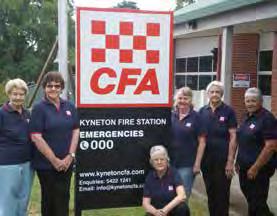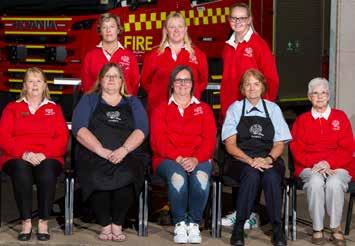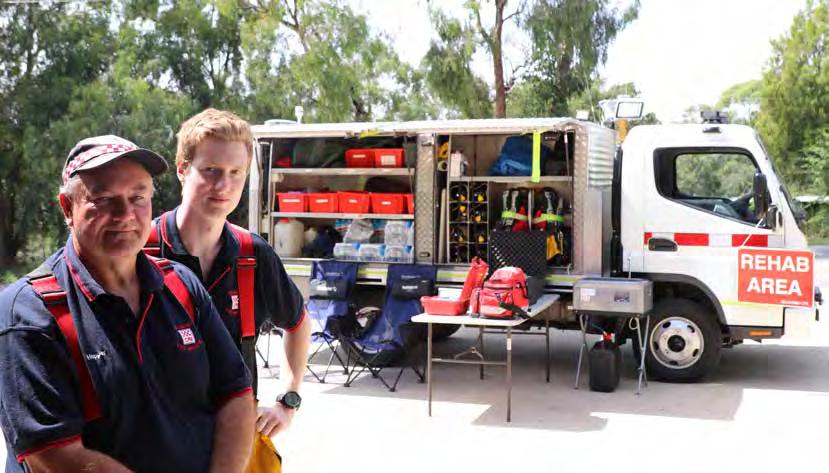
7 minute read
FEATURE
Supporting the frontline
Kyneton Auxiliary always gives a helping hand
Advertisement
When local firefighters are hard at work protecting lives and property from bushfires there are often long-running and passionate community groups, much like the Kyneton Fire Brigade Auxiliary, working behind the scenes to offer their support in a variety of ways. The nine-member auxiliary supports Kyneton Fire Brigade year-round by fundraising for much-needed equipment and also provides catering during incidents attended by the brigade. Kyneton Fire Brigade Auxiliary Secretary and Treasurer Larina Strauch said throughout the auxiliary’s almost six decades of service it has built its reputation for catering. “Our catering is top-notch and we get involved whenever there’s a staging area in Kyneton, which was the case when we sent a strike team to Mallacoota,” Larina said. “We are famous for our homemade slices. When the district and local brigade organise meetings the slice is often their first request.” The community group was established in the 1940s and became directly connected with the brigade in 1962 as an auxiliary brigade. “We’ve had some fairly significant incidents in our district over the past 12 months and we’ve been happy to support our crews through it,” Larina said. “During the Black Saturday bushfires our auxiliary was on duty for eight days straight, making lunches and sending them to the field. “It’s important we continue to show our support and provide this service to our firefighters while they do the work of protecting our communities.” Members are always finding time to pitch in year after year. Larina noted that the
Kyneton auxiliary clocked 369 hours of catering during the 2015-16 financial year and their involvement has remained steadysince. “It’s all about getting together and having that camaraderie among the group. We have meaningful interactions with the members of the fire brigade and have for a long time,” she said. “If you live in a smaller community joining a group like the auxiliary is a great way to give back.”
STORY MITCHELL GASTIN
Ararat Auxiliary prepares for new facilities
Ararat Fire Brigade has been preparing to open the doors of its multi-million-dollar new station (see page 68 for more details) but it’s not just the operational crews who’ve been looking forward to the upgrade. Members of the Ararat Fire Brigade Auxiliary are ready to take advantage of the fully-functional kitchen. It will be a big improvement on the small but tidy space in the old station and will help the 12 current auxiliary members to cater for brigade dinners, fundraising barbecues and district training sessions. The new space was also used to provide lunches for the collectors and brigade members during the Royal Children’s Hospital Good Friday Appeal. Current secretary Rhonda Wall has been involved with the auxiliary for about a decade and said the group generally meets once a month during the summer period, though it hasn’t been doing much lately because of the facilities in the temporary station. “The auxiliary has provided much-needed equipment for the brigade and Junior brigade over the years,” Rhonda said. “It’s a fine body of ladies who work tirelessly in the brigade’s best interests.” And that tireless work has been going on for more than 100 years, with local records suggesting the origins of the auxiliary date back to 1878 when the Ararat Urban Fire Brigade Ladies’ Auxiliary helped 56
provide coffee after a house fire. Other documents state it was formed in 1919 to help with the annual brigade ball. Regardless of when it started the auxiliary is now looking forward to its next chapter in the new station.
STORY MARK BLACKMAN

Feature

Snack Attack feeds hungry firefighters
A District 12 brigade team, affectionately called Snack Attack, re-energises firefighters on the frontline during significant incidents using its food catering capability. Broadford Fire Brigade’s food trailer can be despatched to incidents in District 12 to provide a range of meals and drinks to crews on the ground. Snack Attack is essentially a mobile cool room with a barbecue built onto the side of the trailer. Broadford brigade’s First Lieutenant Luke Crampton said the brigade’s catering capability has been a “vital function” and a “great opportunity for brigade members to give their time without being on the frontline. “Firefighters out on the fireground need nutritious and filling food to keep them healthy and working efficiently on the fireground,” Luke said. “We generally make up hamburgers with salad, roast beef rolls, bacon and egg sandwiches and sausages in bread. “While the district allocates drinking water for crews on the fireground, our Snack Attack trailer also carries soft drinks and distributes them to members.” Luke said the feedback from firefighters has been excellent and emphasised the importance of having friendly faces to greet them and to cater for them. “The district duty officer will generally determine whether the food truck is required. It’s a proven, quick way to transport and prepare more than 100 meals for our crews at one time,” Luke said. Fortunately, the district hasn’t seen many large-scale grass and bushfires or the need for Snack Attack to be used this bushfire season. Most recently the Snack Attack trailer was deployed for 10 days when a fire broke out near the border of Districts 12 and 22. It provided three meals a day to crews.

“Snack Attack was used during Black Saturday and has assisted at local incidents for many years,” Luke said. Fourth Lieutenant Jack Galbraith is one of the members who oversees Snack Attack’s operations. He said its success is because of the effort of volunteers. “The people who are involved in operating and catering the Snack Attack are a mix of operational and non-operational members,” Jack said. “Vehicles used to transport crews to and from the fireground assist in supplying the Snack Attack with more resources, which means Snack Attack can remain on the ground feeding crews.” The Snack Attack has also been pivotal in Broadford Fire Brigade’s fundraising efforts in the local community. “We always try to use it for a sausage sizzle fundraiser in the community every now and again,” Jack said. “Everyone can easily identify the Snack Attack and it’s also a good tool to boost the public’s interest in joining CFA when they see us out and about.”
Supporting the frontline
Feature
PHOTO: MARK BLACKMAN

Rehab units on the rise
The reputation of CFA’s rehab units is continuing to grow, with crews playing key roles on firegrounds during the challenging summer. Greg Hopper and Angus McLean from Yellingbo Fire Brigade’s rehab team were among those helping out in East Gippsland. “We were activated as rehab personnel to go to the Gippsland fires to relieve the Yallourn North team which was working out of their vehicle at the peat fire,” Greg said. “We worked with District 8 personnel and it was really good. If they had a problem, we’d see them every hour and a half to check their hydration and their carbon monoxide levels. “We all worked as a team and everybody knew what they had to do.” Greg and Angus are part of a 12-person rehab team at Yellingbo, which was the first brigade to receive a purpose-built rehab vehicle. Although the rehab team supported East Gippsland this summer, the rehab unit itself wasn’t deployed. “What we had in our field command vehicle was enough to address any injury and of course provide the rehab we needed to do at the fires,” Greg said. Yellingbo brigade’s purpose-built truck has equipment such as cooling chairs to help deal with radiant heat, electrolyte sticks for rehydration, and a snake-bite first-aid kit. But Angus said it was the carbon monoxide monitoring equipment that played a key role at the peat fire in East Gippsland. “Sometimes you can’t see any flame at all; sometimes there’s no smoke, he said. “You don’t need to be in smoke to breathe carbon monoxide.” Angus has been with the rehab unit for five years and said it has definitely played a much bigger role recently. “Initially we were struggling to get out the door to these kinds of jobs,” Angus said. “We’d get called really late and we’d rock up as everyone was packing up. “But more recently, with more exposure about what rehab is and how important it is, we’ve been getting called to jobs much quicker.” There are now 19 rehab health teams across the state, with the newest locations at Woodend and Hamilton coming online this year. Another two brigades also have equipment that can be used to help with surge capacity during times of multiple major incidents. And the recognition is also spreading to interstate fire services. “Tassie brought its specialised trucks over just for the peat fire. They don’t have rehabs in Tassie, not yet at least, so I think it was good for them to see what goes on.” Yellingbo brigade is now working to get an upgraded vehicle, and Angus said there was a bright future for rehab services in CFA. “It would be nice to see rehab units become a staple at every big job.”










